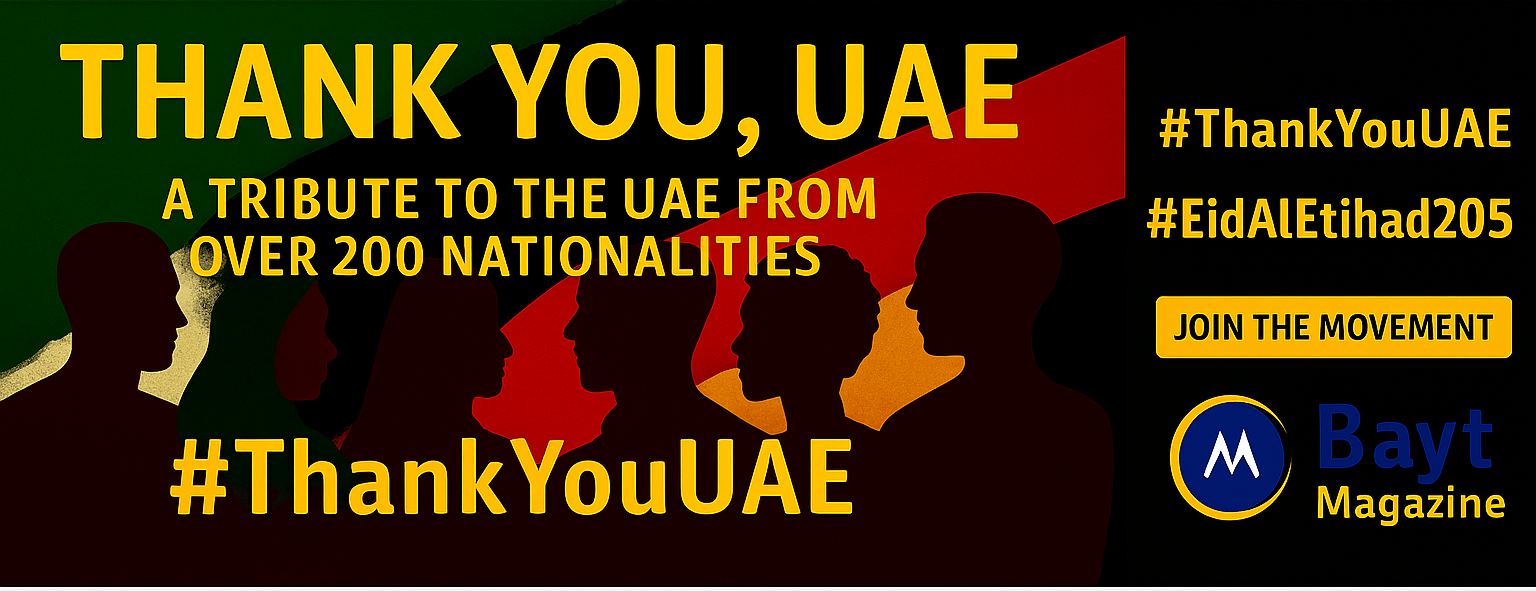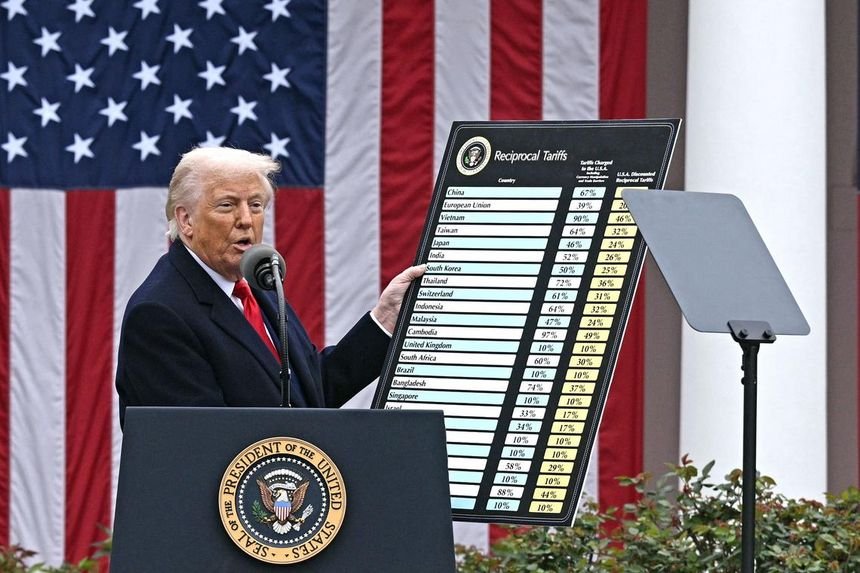President Trump sparked a huge trade war by announcing tariffs that will push U.S. import taxes from 2.5% to 22% – numbers not seen since 1910. Stock markets around the world took an immediate hit. Beijing and Tokyo’s exchanges fell to their lowest points in months, while gold prices shot up to new highs as investors rushed toward safer bets.
These sweeping tariffs hit major trading partners hard. China now faces a massive 54% duty on everything it sends to America, and the European Union must deal with a 20% rate. EU leader Ursula von der Leyen has warned this could spell trouble for millions of people worldwide. Economic experts believe these measures might push the world into a recession. The tariffs kick in on April 5, and many experts call it the biggest shake-up in international trade we’ve seen in recent times.
Trump Unleashes Global Tariff Tsunami: What Happened?

Image Source: The Straits Times
President Donald Trump declared April 2, 2025, as “Liberation Day” at a Rose Garden event, showing sweeping new tariffs that reshape America’s trade relationships with the world. Trump signed an executive order using his authority under the International Emergency Economic Powers Act (IEEPA). The order imposes a baseline 10% tariff on all imports to the United States, with higher “reciprocal” rates targeting specific countries.
Trump Declares ‘Liberation Day’ with Sweeping Tariffs
Trump emphasized that the day “will forever be remembered as the day American industry was reborn, the day America’s destiny was reclaimed and the day that we began to make America wealthy again”. He justified the tariffs by declaring a national emergency over what he described as unfair foreign trade practices. The persistent trade deficits reached AED 4.41 trillion in 2024.
The White House called this initiative “Make America Wealthy Again” and positioned the tariffs to protect American workers and strengthen the country’s international economic position. Trump stated that the United States could “no longer continue with a policy of unilateral economic surrender”.
The 10% baseline tariff starts at 12:01 a.m. EDT on April 5, 2025. The higher reciprocal tariffs begin at the same hour on April 9. Trump also ended the duty-free “de minimis” exemption permanently for packages from China and Hong Kong valued under AED 2937.55. This closed what he called a loophole that Chinese e-commerce companies exploited.
How Countries Face Different Tariff Rates
The administration calculated individualized “reciprocal” tariffs for about 60 countries with which the United States has major trade deficits. These rates factored in what Trump called “combined rate of all their tariffs, nonmonetary barriers and other forms of cheating”.
White House officials say the reciprocal rates are roughly half of what other countries allegedly charge the United States. The highest rates target Asian manufacturing hubs and strategic competitors:
China faces a 34% reciprocal tariff—which adds to the existing 20% tariff imposed in February—bringing the total to 54%. Vietnam received the highest major economy rate at 46%, while Cambodia faces the steepest overall tariff at 49%. The European Union will see a 20% tariff, Japan 24%, South Korea 25%, and India 26%.
Treasury Secretary Scott Bessent warned countries not to retaliate and advised them to “sit back, take it in”. The administration stated that Trump can increase tariffs if trading partners retaliate or decrease them if countries “take significant steps to remedy non-reciprocal trade arrangements”.
Which Nations Escaped the Tariff Net?
All but one of these countries received only the baseline 10% tariff despite having trade relationships with the United States. The United Kingdom, Brazil, Singapore, and Australia avoided the higher reciprocal rates. Many of these countries either run trade deficits with the U.S. or have trade policies deemed more fair, according to administration officials.
Russia was absent from Trump’s tariff list despite running a AED 9.18 billion goods trade surplus with the U.S. in 2024. Goods from Canada and Mexico that comply with the United States-Mexico-Canada Agreement (USMCA) received a major exemption. USMCA-compliant goods will continue to see a 0% tariff, though non-compliant goods face a 25% duty.
Some product categories received exemptions from the reciprocal tariffs. Imports already subject to separate 25% tariffs under Section 232 of the Trade Act of 1962—including automobiles, auto parts, steel, and aluminum—were excluded. The exemption covers sectors under national security investigations, such as copper, lumber, semiconductors, and pharmaceuticals, as well as certain critical minerals and energy products.
This broad tariff regime marks a dramatic shift from the previous U.S. approach to international trade, which managed to keep one of the world’s lowest average tariff rates at 3.3%.
Global Leaders Condemn Tariffs and Vow Retaliation

Image Source: Al Jazeera
The world reacted strongly when Trump announced new tariffs. Major economic powers promised to hit back against what they saw as an attack on global trade rules.
China Promises Countermeasures Against 54% Tariff
Beijing hit back hard at the combined 54% tariff burden—a new 34% levy on top of existing duties. China’s Commerce Ministry asked Washington to “immediately cancel” the tariffs. They called it a “typical unilateral bullying practice” that would “endanger global economic development”. The ministry promised to “resolutely take countermeasures to safeguard its own rights and interests”.
Chinese officials flipped the script on the United States. They condemned the tariffs as a “unilateral violation of international rules”—words Washington often used against China. Analysts from Renmin University suggested Beijing might answer with matching tariffs, adjust its currency, or limit exports of vital rare earth elements.
EU Prepares Response to ‘Major Blow to World Economy’
European Commission’s President Ursula von der Leyen didn’t mince words. She called Trump’s decision “a major blow to the world economy” that would bring “dire consequences for millions of people around the globe”. Speaking from Uzbekistan, she cautioned that “uncertainty will spiral and trigger the rise of further protectionism”.
Von der Leyen stressed European solidarity: “If you take on one of us, you take on all of us”. The EU now puts finishing touches on “a first package of countermeasures in response to tariffs on steel” and “preparing for further countermeasures to protect our interests and our businesses if negotiations fail”.
European leaders felt particularly upset about being grouped with adversaries. “I know that many of you feel let down by our oldest ally,” von der Leyen told Europeans. The EU stands ready to push back through potential barriers for services, which could hurt American tech giants like Apple and Meta.
Allies Express Shock: ‘Not the Act of a Friend’
America’s traditional allies couldn’t believe they faced punitive tariffs. Australian Prime Minister Anthony Albanese spoke most directly: “The administration’s tariffs have no basis in logic and they go against the basis of our two nations’ partnership. This is not the act of a friend”.
South Korea’s acting President Han Duck-soo gathered his economic team for crisis talks. He called the situation “extraordinarily serious” and said a global trade war “has become a reality”. Japanese Trade Minister Yoji Muto called the 24% tariff on Japanese goods “extremely regrettable” and possibly against World Trade Organization agreements.
Italy’s Prime Minister Giorgia Meloni had just visited Trump at Mar-a-Lago. Yet she called the move “wrong” and warned of a trade war that “would weaken the West in favor of other global actors”. Ireland’s Prime Minister Micheál Martin put it simply: “I strongly believe that tariffs benefit no one”.
Treasury Secretary Scott Bessent warned other countries on Fox News: “If you retaliate, there will be escalation”. All the same, former U.S. trade negotiator Wendy Cutler pointed out America’s partners’ tough spot: “Our close partners appear to be treated similarly to our rivals”. British Prime Minister Keir Starmer summed it up: “Nobody wins in a trade war”.
Markets Tumble as Trade War Fears Intensify

Image Source: IG
Stock markets worldwide took a nosedive after President Trump announced sweeping tariffs. Investors reacted strongly as analysts now call it a full-blown global trade war.
Asian Markets Lead Global Selloff
Japanese exchanges took the hardest hit in the first wave of reactions. The Nikkei index plunged 4.6% to an eight-month low before bouncing back slightly to end down 2.8%. The standard entered correction territory for the first time since October. Other Asian markets quickly followed the downward trend. Hong Kong’s Hang Seng dropped 1.5%. South Korea’s KOSPI fell 2.7%. Vietnam, which faced a steep 50% tariff, tumbled dramatically by 6.7%.
Manufacturing and technology companies saw the steepest losses. Toyota’s shares fell more than 5%. Sony plummeted 5.4% while Honda dropped over 4%. Samsung and Hyundai each declined more than 3% in South Korea.
European markets also took substantial hits. Germany’s DAX dropped 1.3%. France’s CAC fell 1.6%. The pan-European STOXX 600 slipped 1.7%. Consumer brands felt the impact severely. Adidas and Puma tumbled approximately 9% each. Danish jewelry company Pandora, which makes its products in Thailand, plunged 12%.
Wall Street showed signs of upcoming turmoil through U.S. futures. Dow futures dropped 2.4%. S&P 500 futures slid 2.9%. Tech-heavy Nasdaq futures plummeted 3.2%. Nike fell more than 8% in premarket trading. Apple dropped 6%. Nvidia declined 3%. Tesla sank 8%.
Gold Hits Record High as Investors Seek Safety
Gold prices shot up to unprecedented levels as market volatility grew worse. The precious metal reached above AED 11,603 per ounce—its eighteenth record high this year. The first quarter of 2025 saw a 19% rise, marking gold’s largest quarterly gain since 1986.
“It continues to be the safe-haven demand on ramped-up concerns about tariffs, trade and ongoing geopolitical uncertainty,” explained Peter Grant, vice president at Zaner Metals.
Investors rushed to government debt as another safe option. The yield on 10-year U.S. Treasury bonds fell to 4.08%, reaching its lowest point since October. Oil prices also dropped sharply. Brent crude fell 4% to approximately AED 264 per barrel as recession fears grew stronger.
Most economists expect Trump’s tariffs will drive prices up and weaken consumer demand. This combination could lead to stagflation—a dangerous mix of rising inflation and slowing growth.
Trade War Definition: How History Judges Economic Conflicts

Image Source: Visual Capitalist
Trade wars create economic chaos by building barriers between nations. A trade war happens at the time one government believes another country uses unfair trading practices that damage their domestic markets.
Smoot-Hawley Tariffs and the Great Depression
The Smoot-Hawley Tariff Act of 1930 serves as history’s most powerful warning about protectionism. President Herbert Hoover signed this legislation despite strong opposition from more than 1,000 economists. The act raised duties on more than 20,000 imported goods. These changes pushed average tariffs up by about 20%, which drove rates to almost 60% on certain products.
The damage was immediate and severe. Other countries struck back with their own trade barriers. Nearly two dozen nations adopted similar “beggar-thy-neighbor” duties. U.S. imports dropped by 66% from AED 16.16 billion in 1929 to AED 5.51 billion in 1933. Exports crashed 61% from AED 19.83 billion to AED 7.71 billion. The world’s trade shrank by about 66% between 1929 and 1934.
US-Japan Trade Tensions of the 1980s
The 1980s saw U.S.-Japan trade tensions rise due to market imbalances and America’s manufacturing decline. This conflict differed from Smoot-Hawley’s broad approach. It used specific measures like “voluntary export restraints” on Japanese cars and a controversial 1986 semiconductor agreement.
Japan had to stop “dumping” practices under the semiconductor agreement. They also needed to help foreign producers secure 20% of their domestic market. These measures produced mixed results. Japanese manufacturers reaped huge benefits—they reportedly earned AED 4.41 billion from DRAM sales in 1988 alone. American computer makers struggled with higher component costs.
Lessons from Previous Trade Wars
History shows clear patterns in trade conflicts:
Retaliation cycles expand disputes way beyond the reach and influence of their original scope. Canada responded to Smoot-Hawley by adding new tariffs on 16 products that made up 30% of U.S. exports to Canada.
Protection measures usually create focused benefits but spread larger economic costs. The recent U.S.-China trade war cut American GDP by 0.2%-0.4% and raised prices by 0.1%-0.3%.
Consumers bear the heaviest burden through higher prices. A Chicago Booth survey showed that none of the 43 economic experts believed U.S. tariffs on steel and aluminum would help Americans’ welfare.
History teaches us that trade wars might protect specific industries briefly. However, they ended up causing lower economic output, fewer jobs, and worse diplomatic relationships.
Who Won the Trade War? Examining Potential Victors

Image Source: Statista
The Trump administration’s tariff tsunami left economic disruption in its wake, though some countries and industries managed to dodge the worst effects. Few came out as clear winners in the long run.
Countries with Tariff Exemptions
The US-Mexico-Canada Agreement (USMCA) helped Canada secure protection from both 10% baseline and reciprocal tariffs. All the same, Canadians must deal with a 25% tariff on most goods and 10% on energy exports starting February 2025. Prime Minister Mark Carney promised to “fight these tariffs with countermeasures” and “build the strongest economy in the G7”.
Mexico got similar protection through USMCA. President Claudia Sheinbaum said her country would avoid a “tit-for-tat on tariffs” and launch a “detailed program” instead.
Nations already facing U.S. sanctions or high tariffs stayed clear of new ones. This included Cuba, Belarus, North Korea, and Russia – U.S. sanctions on Moscow already “preclude any meaningful trade”. Australia only faced the baseline 10% tariff and got exemptions for critical minerals not found in the U.S..
Industries Positioned to Benefit
U.S. steel and aluminum producers stand to gain the most from tariff protection. Companies making alternatives to tariffed materials found unexpected advantages. Bedford Reinforced Plastics, which makes alternatives to concrete blocks and steel pilings, saw “double digit” revenue growth after earlier tariffs took effect.
Massachusetts-based Pearson Pilings, which makes fiberglass pilings for waterfront construction, had its best year in a decade. Companies producing alloys that extend galvanized steel’s lifespan also reported major business growth.
The Paradox: Why Trade Wars Often Have No Winners
History shows trade conflicts create mostly losers. Protective tariffs start a dangerous cycle – they drive up consumer prices and increase costs for U.S. manufacturers that need foreign materials. This hurts American products’ competitiveness worldwide.
Trading partners hit back with their own tariffs, which damages export potential. The stronger dollar that comes with trade tensions makes American goods cost more abroad.
Trade disputes only bring short-term gains. Vietnam’s exports to the U.S. grew 40% when Chinese businesses moved operations there to avoid American tariffs. This advantage didn’t last long – Vietnam soon became a tariff target too.
The uncertainty of trade conflicts reduces investment. About 30% of U.S. manufacturers changed their spending plans during previous trade tensions. British Prime Minister Keir Starmer put it best: “Nobody wins in a trade war”.
Trump’s sweeping tariff announcement stands as a defining moment in global trade history. This move created market chaos and drew criticism from countries worldwide. So major economies now must choose between protecting their own interests and keeping global trade relationships intact. Stock markets crashed globally, and gold prices hit new records as investors looked for safer places to put their money.
The Smoot-Hawley Tariff Act from the past shows how dangerous escalating trade conflicts can be. All the same, some sectors and countries found ways to benefit, though these gains might not last long. A complex system of back-and-forth tariffs, from China’s 54% to the EU’s 20%, now threatens to break supply chains and drive up prices for consumers everywhere.
Market reactions tell the real story. The Nikkei fell 4.6%, and similar drops in Asian and European markets point to deep worries about global economic stability. Countries now think about hitting back, which could lead to a long trade war. History shows these conflicts usually hurt everyone’s economy instead of creating clear winners.
This dramatic change in U.S. trade policy breaks away from decades of working together with other economies. The next few months will show if these measures work as planned or, as many economists think, slow down growth and push inflation higher worldwide.






